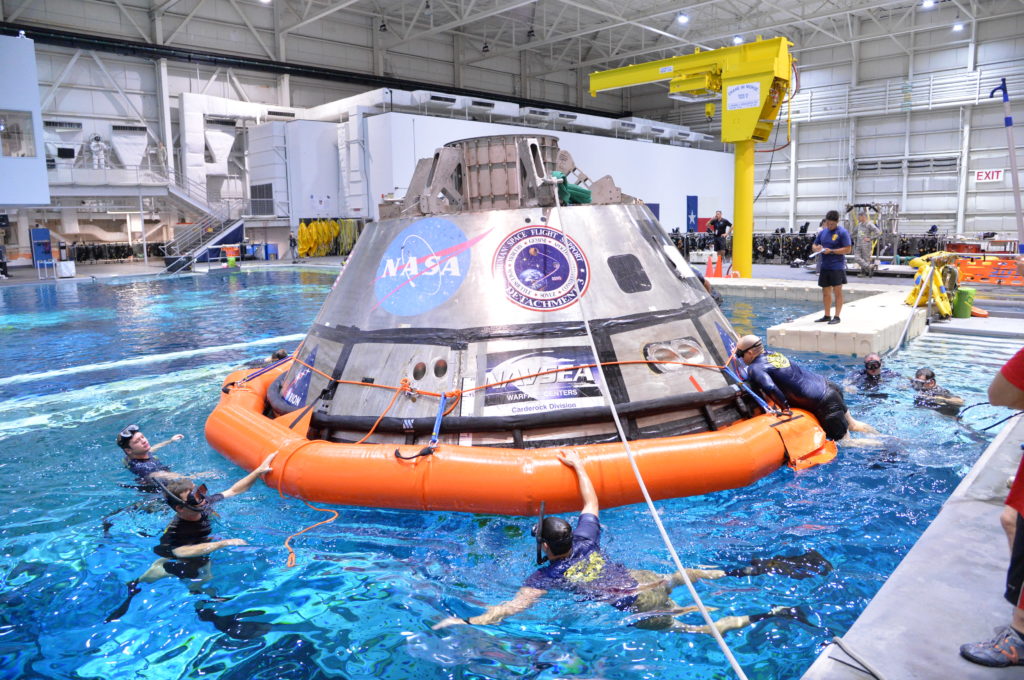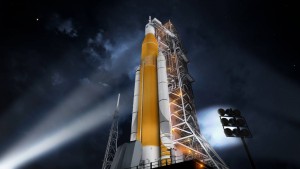Having already completed a successful test flight in 2014, NASA’s Orion capsule continues to prepared for its upcoming flight in 2018.
The Orion spacecraft will launch on top of NASA’s new rocket, Space Launch System (SLS), for the first integrated flight in 2018. This flight, Exploration Mission-1 (EM-1), and will be unmanned. In future missions that carry humans onboard, Orion will take them deeper into space than they’ve ever gone before.
We know that 2017 will be a busy year for Orion before its flight, but last year was full of progress for this new deep space crew vehicle.
Let’s take a look at how the different components of Orion connect to one another and the SLS rocket that will send them to space. The image below shows the service module on the left, and the crew module and launch abort system on the right.
Image credit: NASA
Here’s what it will all look like together on top of SLS during its launch next year:
Image credits: NASA/MSFC
To get an idea of the progress made in 2016, let’s take a closer look into the last few months of the year for Orion.
In November, scientists at NASA worked on a variety of food bars that will help meet the requirements for mass reduction of the supplies carried by Orion. The food bars are being designed to a specific nutritional balance and must pass a taste test and support increased caloric density.
Solar arrays are an important part of the Orion service module, the spacecraft component which provides the crew with power, propulsion and life support systems. The service module is being provided by the European Space Agency (ESA) and components are being delivered to the location of its assembly in Bremen, Germany by suppliers from the U.S. and 10 countries across Europe.
At NASA Glenn’s Plum Brook Station in Ohio, the second solar panel deployment test was successfully completed. The deployment test followed acoustic and vibration tests to make sure the arrays will deploy after their launch on SLS. Also at Plum Brook Station, a full-scale test version of the service module underwent tests to simulate the shocks that the module will experience during Orion’s separation from SLS.
The adapter that connects the Orion crew module to the service module is called the crew module adapter (CMA) and was lifted and lowered onto a test stand for secondary structure outfitting in November at NASA’s Kennedy Space Center in Florida. This would be followed by propellant and environmental control and life support system tube installation and welding.
Orion crew module adapter. Photo credit: NASA/Glen Benson
After Orion returns to Earth following its flight tens of thousands of miles beyond the moon, it will splash down into the Pacific Ocean. The mechanism for capturing and handling the Orion crew module after its splashdown was tested at NASA’s Ames Research Center in California. The crew module recovery mechanism (CMRM) was validated to ensure it will operate properly when handling the still-hot capsule that will be a result of its re-entry into Earth’s atmosphere.
In October, testing off the coast of California was conducted to practice the recovery of Orion. Performed by the U.S. Navy and NASA using the USS San Diego, it was the first major integrated test in a series used to prepare the recovery team for Orion’s return.
A series of tests to qualify the parachute system for Orion began on September 30th when a test article was dropped out of an aircraft at an altitude of 35,000 feet, much higher than 24,000 feet which is generally where the parachute sequence begins. As the first of eight trials, this test investigated how the parachute system performed during conditions of the highest dynamic pressure experienced by the parachutes.
Blocks made of a special material were pre-fitted around the crew module heat shield at Kennedy Space Center in October. The material is called Avcoat, which sheds away as it heats up. The heat shield is an essential part of the spacecraft as it protects the crew module and future astronauts from the extreme heat of reentry into Earth’s atmosphere. Meanwhile, the heat shield used on Orion’s test flight in 2014 began its transport from NASA’s Langley Research Center in Virginia to Kennedy Space Center where it will undergo evaluation for future needs after being used in drop tests aimed at understanding Orion’s landing in the ocean.
Back at Plum Brook Station, a series of tests finished in October on a test version of the service module. This full-size version went through vibration testing to make sure it can withstand the forces of launch and travel into space on top of SLS.
In September, recovery techniques for Orion after it returns to Earth and splashes into the ocean were practiced in the Neutral Buoyancy Laboratory (NBL) at NASA’s Johnson Space Center. U.S. Navy divers, Air Force pararescuemen and Coast Guard rescue swimmers used ground support equipment and zodiac boats to approach a test version of the Orion spacecraft. Placing a flotation collar around the spacecraft, they used new tow cleat modifications that connected tether lines to the capsule, which were used to simulate towing the spacecraft into a Navy recovery ship’s well deck.
Photo credit: NASA/James Blair
Also in September, the heat shield for Orion was secured on a stand at Kennedy Space Center in the Neil Armstrong Operations and Checkout Building. Here, the material that wears away as it heats up, Avcoat, would be bonded to the heat shield. After the application and inspection of the thermal protection system, the heat shield would be tested to make sure the blocks were properly bonded and will perform as expected during extreme temperatures on Orion’s 2018 flight.
Orion engineers worked with astronauts on creating safe shelter from space radiation onboard the Orion spacecraft. During deep space missions, the stowage bags that contain supplies, food and water and the seats will be used to make the shelter. Higher density bags will be placed in areas of Orion that have less materials that protect against radiation.
2016 was an incredibly busy year for the Orion crew capsule. When Orion takes flight next year and travels past the moon on its first mission with SLS, it will travel farther into space than any human-rated spacecraft will has ever gone, opening up the future of human missions into deep space.
Learn more about Orion at NASA.gov.





